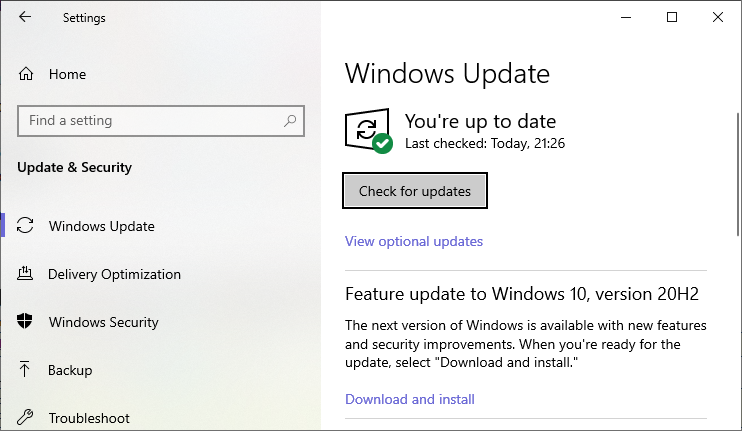Update types
Windows differentiates between various update types:
- OS Feature updates
- OS Security updates
- Device drivers
- Defender definition updates
Apparently, a user can opt-in to also manage Office update with USO.
Note: Store apps are not updated by the Update Session Orchestrator.
Updating Windows from PowerShell
First, the psWindowsUpdate module needs to be installed.
install-Module psWindowsUpdate -force
With this module, Windows can be updated like so:
get-windowsUpdate
install-windowsUpdate
Feature Update
When opening Windows Update Settings using
start ms-settings:windowsupdate (2021-02-02), I found the following situation, which seems to indicate that
feature updates are treated differently from ordinary(?) updates:

Performing a feature udpate, for example from 1909 to 2004, can be executed like so:
$destDir = "$env:temp\FeatureUpdate"
mkdir $destDir
$webClient = new-object System.Net.WebClient
$exe = "$destDir\Win10Upgrade.exe"
$webClient.DownloadFile('https://go.microsoft.com/fwlink/?LinkID=799445', $exe)
start-process -filePath $exe -argumentList '/quietinstall /skipeula /auto upgrade /copylogs $destDir'
# check if still running:
while (get-process Windows10UpgraderApp) { start-sleep 1 }; 'done'
# Check if updated
get-itemPropertyValue 'HKLM:\SOFTWARE\Microsoft\Windows NT\CurrentVersion' ReleaseId
Quick Fix Engineering (QFE) update
A
Quick Fix Engineering (QFE) update is a small system-wide update that is applied to the
Windows Operating System and its components such as the
Internet Explorer (IE), Windows Server Roles and features.
Querying the update history
Quick Fix Engineering updates
PS C:\Windows\system32> get-hotfix
Source Description HotFixID InstalledBy InstalledOn
------ ----------- -------- ----------- -----------
DESKTOP-1S... Update KB4534131 NT AUTHORITY\SYSTEM 2/22/2020 12:00:00 AM
DESKTOP-1S... Update KB4465065 NT AUTHORITY\SYSTEM 7/27/2019 12:00:00 AM
DESKTOP-1S... Update KB4470502 1/8/2019 12:00:00 AM
DESKTOP-1S... Security Update KB4470788 1/8/2019 12:00:00 AM
DESKTOP-1S... Security Update KB4480979 1/8/2019 12:00:00 AM
DESKTOP-1S... Update KB4486153 NT AUTHORITY\SYSTEM 2/1/2020 12:00:00 AM
DESKTOP-1S... Update KB4486159 NT AUTHORITY\SYSTEM 2/3/2020 12:00:00 AM
DESKTOP-1S... Security Update KB4504369 NT AUTHORITY\SYSTEM 7/27/2019 12:00:00 AM
DESKTOP-1S... Security Update KB4509095 NT AUTHORITY\SYSTEM 7/27/2019 12:00:00 AM
DESKTOP-1S... Security Update KB4512577 NT AUTHORITY\SYSTEM 9/27/2019 12:00:00 AM
DESKTOP-1S... Security Update KB4516115 NT AUTHORITY\SYSTEM 9/27/2019 12:00:00 AM
DESKTOP-1S... Security Update KB4521862 NT AUTHORITY\SYSTEM 10/21/2019 12:00:00 AM
DESKTOP-1S... Security Update KB4523204 NT AUTHORITY\SYSTEM 11/13/2019 12:00:00 AM
DESKTOP-1S... Security Update KB4537759 NT AUTHORITY\SYSTEM 2/22/2020 12:00:00 AM
DESKTOP-1S... Security Update KB4532691 NT AUTHORITY\SYSTEM 2/22/2020 12:00:00 AM
More or less the same result can be obtained with
wmic.exe:
C:\> wmic qfe list
…
Reporting all updates
The
COM Object Microsoft.Update.Session allows to query the update history of applications (as opposed to QFE updates):
PS C:\> $wuSess = new-object -comObject Microsoft.Update.Session
PS C:\> $wuSearch = $wuSess.createUpdateSearcher()
PS C:\> $wuSearch.search("isInstalled=1").updates | select-object lastDeploymentChangeTime, title
LastDeploymentChangeTime Title
------------------------ -----
5/16/2019 12:00:00 AM 2019-02 Update for Windows 10 Version 1809 for x64-based Systems (KB4465065)
8/13/2019 12:00:00 AM Microsoft .NET Framework 4.8 Language Packs for Windows 10 Version 1809 for x64 (KB4087642)
2/11/2020 12:00:00 AM Windows Malicious Software Removal Tool x64 - February 2020 (KB890830)
2/11/2020 12:00:00 AM 2020-02 Cumulative Update for .NET Framework 3.5, 4.7.2 and 4.8 for Windows 10 Version 1809 for x64 (KB4538122)
2/11/2020 12:00:00 AM 2020-02 Security Update for Adobe Flash Player for Windows 10 Version 1809 for x64-based Systems (KB4537759)
3/4/2020 12:00:00 AM Update for Windows Defender Antivirus antimalware platform - KB4052623 (Version 4.18.2001.10)
2/11/2020 12:00:00 AM 2020-02 Cumulative Update for Windows 10 Version 1809 for x64-based Systems (KB4532691)
2/18/2020 12:00:00 AM 2019-12 Update for Windows 10 Version 1809 for x64-based Systems (KB4023057)
TODO: with PowerShell
Apparently, some update related log entries can be queried in
PowerShell like so:
PS C:\> get-eventLog system -source Microsoft-Windows-WindowsUpdateClient | select-object timeGenerated, message
PS C:\> get-winEvent setup

